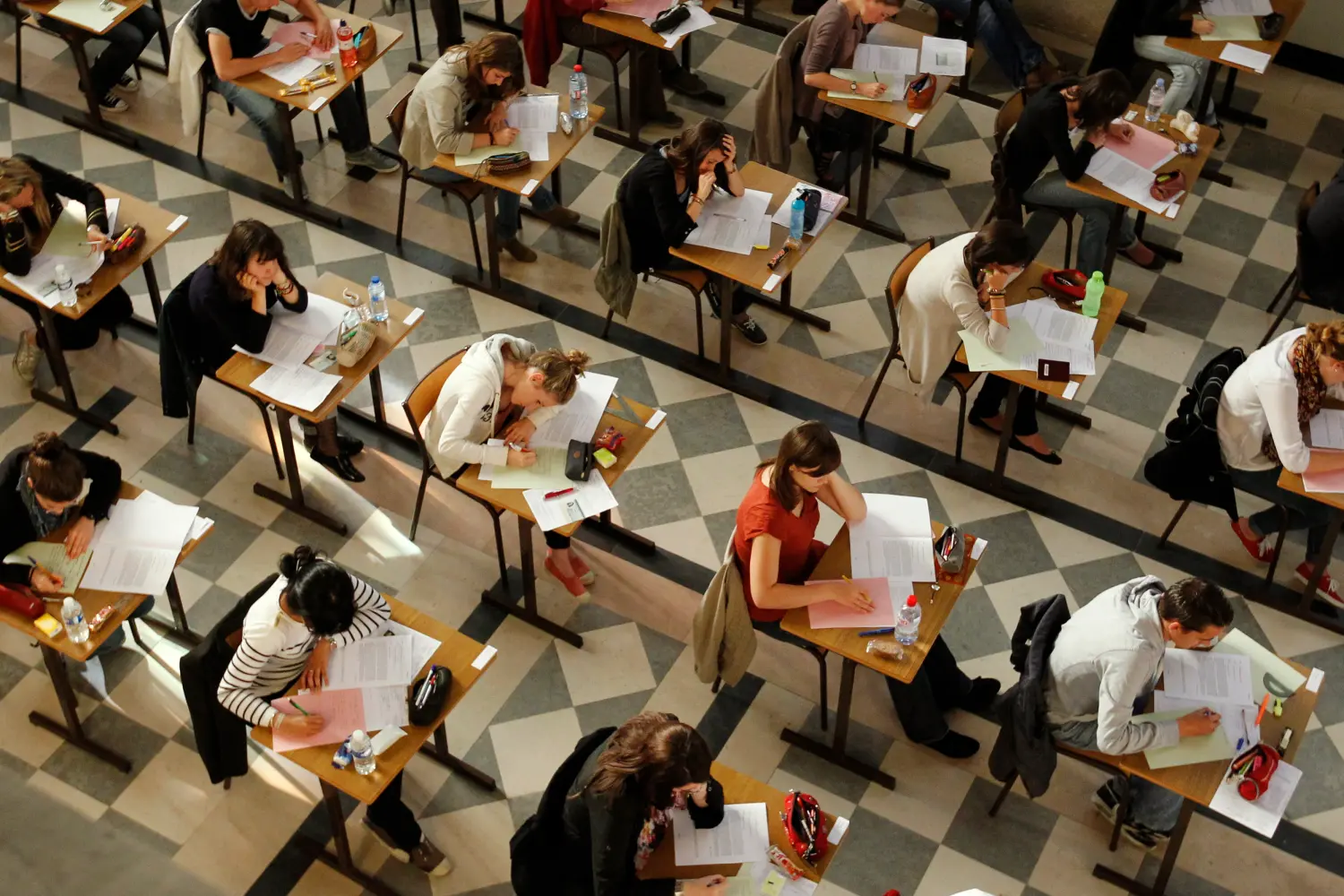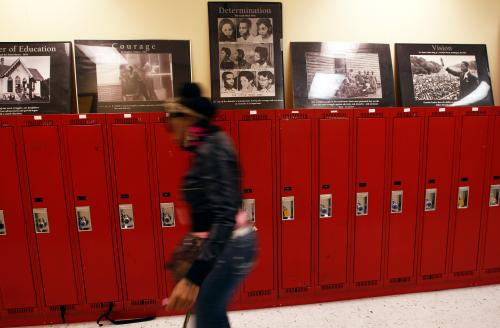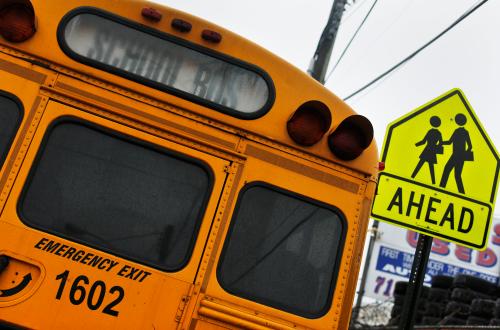This post is part of “Teacher diversity in America,” a series from the Brown Center on Education Policy that examines minority underrepresentation among public educators in the U.S.
Hispanic students comprise the largest minority demographic in the nation’s schools, accounting for 26% of students as of 2016. Indeed, the shift in school demographics to a majority-nonwhite student body is largely driven by the growth in the Hispanic population.
Even though Hispanics constitute a major share of the American student population, they continue to face barriers in accessing a quality public education. Many Hispanic students live in poverty or have parents who have not completed high school, attend highly segregated schools, and have a long history of being grouped into low academic tracks.
Because teachers of color serve as role models, and tend to hold higher expectations for students of color, school leaders are increasingly warming to the idea of providing students regular access to teachers who share their ethnic or racial background–including Hispanic students. A growing body of literature demonstrates that students who have demographically similar teachers exhibit better academic outcomes. Most of this research, however, has focused on the relationship between Black teachers and Black students, and there is little empirical evidence on the benefits of ethnic match for Hispanic students.
Two relatively recent studies suggest that Hispanic teachers play a role in Hispanic representation in gifted programs and in STEM courses. Grissom, Rodriguez, and Kern reported that a 10% increase in the share of Hispanic teachers in an elementary school is associated with a 3.1% increase in Hispanic participation in gifted programs. Further, Hispanic student exposure to Hispanic math and science teachers in middle and high school tends to increase the likelihood of Hispanic students taking STEM courses during their freshman year in college.
Today, the Brown Center’s ongoing series on teacher diversity celebrates Hispanic Heritage Month by shedding light on a way in which Hispanic teachers appear to contribute to student outcomes. Following Grissom and colleagues, I merge two nationally representative datasets to explore the relationship between student enrollment in advanced courses and the share of Hispanic teachers. I find that schools with a higher share of Hispanic teachers tend to have a higher percentage of Hispanic students taking Advanced Placement (AP) courses. Though these results do not prove a causal relationship, they suggest a potential channel through which attracting and retaining teachers of color—particularly Hispanic teachers—might benefit students.
AP courses and college outcomes
The AP program was created in the mid-1950s to enable elite high school students to take college-level courses and earn college credit while in high school. The program widely expanded across American high schools in the late 1990s, though gaps in access persist.
Research on participation in the AP program and subsequent student outcomes reveals that merely taking AP classes is not generally correlated with improved outcomes. However, taking an AP course and passing the exam is associated with a number of positive postsecondary outcomes, including college enrollment, college GPA, and college graduation rates.
Further, selective universities place substantial weight on students’ participation in college-preparatory courses and student GPA (which can be inflated by grades in AP courses). This is particularly important for Hispanic students because they are barely represented in selective universities and these institutions provide higher rates of upward mobility. Consequently, expanding the chances of Hispanic students to get admitted to selective universities is promising for improving Hispanic students’ labor market outcomes.
Hispanic students’ exposure to and participation in AP courses
Before diving into the relationship between Hispanic teachers and Hispanic participation in AP courses, I explore the extent to which Hispanic students are exposed to AP courses and their enrollment rates in such courses.
I use the 2015 Civil Rights Data Collection (CRDC), a national survey of U.S schools that contains information on the number of students enrolled in AP math, AP science, and other AP courses disaggregated by race/ethnicity. Because students typically take AP classes during their junior or senior years, I restrict the sample to schools with students enrolled in those grades (and exclude virtual and alternative schools). The sample comprises nearly 18,000 high schools, 71% of which offer at least one AP course.
The top panel of Figure 1 below shows the percentage of students of each race/ethnicity that attend schools that offer at least one AP course. The overwhelming majority of all students are enrolled in schools that offer AP courses, with relatively little variation across racial/ethnic groups. This broad access is consistent with the efforts of the federal government, states, and The College Board to expand the program across American schools.
Exposure to rigorous courses, however, does not guarantee participation. The bottom panel of Figure 1 shows the average percentage of 11th/12th-grade students enrolled in various AP courses among the schools that offer such courses. AP enrollment rates for Hispanic (and Black) students lag far behind those of white and “other race” students (which mostly consists of Asian Americans, the next highest group after Hispanics and Blacks). This might understate the gaps, too, since Hispanic students are more likely to drop out of high school than their white peers.
The CRDC also reports the number of students who took at least one AP exam and the number who passed at least one exam. The figure below shows that participation rates in exams follow a similar pattern to the one observed for taking AP courses. Students in the “other race” category are ahead, while Hispanic and Black students fall behind. Hispanics lag on both participation and passing measures, as only 25% of Hispanic students took at least one exam and 10% passed at least one exam.
Does the share of Hispanic teachers in a school contribute to Hispanic participation in AP courses?
I posit that Hispanic teachers can inspire students to enroll in AP courses. Beyond role modeling and higher expectations, another potential mechanism for this relationship could be through Hispanic teachers raising students’ awareness of the importance of these courses for college admission and subsequent academic outcomes, though this cannot be observed directly.
To estimate the relationship between Hispanic teachers and Hispanic student participation in these rigorous courses, I combined the CRDC sample with the National Teacher and Principal Survey to obtain information on teacher demographics in each school. Following a similar approach to Grissom, Rodriguez, and Kern, I regressed Hispanic students’ AP course participation rates on the percentage of Hispanic teachers in the school, controlling for a set of school factors, including share of minority students, principal’s race, students in poverty, Title I status, school size, school sector, school locale, school district size, and per-pupil expenditure (and state fixed effects).
The results show a positive relationship between the share of Hispanic teachers in a school and the percentage of Hispanic students enrolled in AP courses. A 10-percentage-point increase in the share of Hispanic teachers is associated with a 1.15-percentage-point increase in Hispanic enrollment in AP Math, 1.2 percentage points in AP science, and 2.5 percentage points in AP courses other than AP Math and AP Science. For example, given the current participation rate of Hispanic students in AP Math, an increase in the Hispanic teacher share from 20% to 30% is associated with an increase from 9.3 percent to 10.5 percent in Hispanic enrollment in AP Math.
The share of Hispanic teachers is also correlated with the rate of Hispanic students taking at least one AP exam and, to a lesser extent, the percentage of students passing at least one exam.
A few caveats are in order. The results presented here do not necessarily reflect a causal relationship between Hispanic teachers and Hispanic student participation/success in the AP program. It is possible that other, non-observable factors are driving the relationship, despite my best efforts to control for the relevant variables. Further, the data used in this analysis do not have information on the race/ethnicity of AP teachers specifically—data that would be helpful for identifying mechanisms. For example, it is unclear whether the relationships I observe reflect Hispanic students wanting to sign up for AP courses taught by Hispanic teachers, feeling supported and empowered by having Hispanic teachers more generally (inside or outside of the AP program), or a mixture of both (or neither) of these.
These results suggest that, as policymakers seek to diversify the teaching profession, a better understanding of the many ways in which Hispanic teachers strengthen U.S. public schools is needed. Future research using student-level or longitudinal data is needed to explore the causal impact of Hispanic students being exposed to Hispanic teachers, and whether the effects vary across student grades and outcomes.
In the meantime, let’s express our appreciation for all of the ways that Hispanic teachers enrich America’s schools, hold high expectations for Hispanic students, and contribute to these students’ academic experience in countless ways.
Thanks to Michael Hansen and Jon Valant for their helpful feedback with this analysis.
The Brookings Institution is committed to quality, independence, and impact.
We are supported by a diverse array of funders. In line with our values and policies, each Brookings publication represents the sole views of its author(s).












